PROTECT YOUR DRAWN HONEY COMB
Drawn comb is a precious commodity to both bees and beekeepers.
It takes 8 oz. of honey to create 1 oz. bees wax, and yet there are beekeepers who sell honey in the comb as a marketing strategy to folks who chew it up and spit it out. So extracting honey and saving the honey comb for use by the honey bees saves labor for the honey bees. So if you are in beekeeping as a business and wanted to get the most from your workforce, honeybees, you would use your resources wisely. That also means pricing precious honey comb and honey far higher, than many now do. Accordingly, honey should be priced as a precious commodity, since local honey is more valuable than store shelf adulterated honey, some imported sweeteners, and other mixtures.
Drawn comb needs to be carefully stored.
 Wax moths are will attack any bees wax but are particularly attracted to the protein left behind from larva’s molted skins in comb where eggs and larvae and brood were raised. Mice, ants, and roaches will also be attracted to stored drawn honey comb.
Wax moths are will attack any bees wax but are particularly attracted to the protein left behind from larva’s molted skins in comb where eggs and larvae and brood were raised. Mice, ants, and roaches will also be attracted to stored drawn honey comb.
If a hive has failed or is failing in the fall, sometimes it is better to shut it down immediately and remove the bees. Weak, failing hives are very susceptible to small hive beetle, wax moth, and mice infestations. These infestations can ruin comb to the point where it is unusable. You can either combine the failing hives into a stronger hive using the newspaper method or if only a few remaining, shake the bees out of the hive in front of other colonies where they can gain entrance and join up with other colonies. Use this experience to determine why a hive is failing to make you a better beekeeper.
Before storing frames of honey comb, freeze them (both brood raised honey comb & honey super honey comb) for at least two days to kill wax moth eggs (tiny black specks difficult to see) and hive beetles. Store frames of honey comb and seal comb immediately upon removing from freezer.
Do not store wet honey supers (comb that has recently been extracted).
Mold called bloom will grow on it and it attracts pests such as ants. You can set the supers away from your apiary to let the bees clean the remaining honey. Do not set frames of honey comb near your apiary because this may cause robbing. Some comb, brood and honey, will collect bloom anyway due to the remaining moisture. This mold is not harmful to the bees or humans and strong hives will clean it fairly quickly in spring.
After freezing, if you could not freeze both box and frames, replace frames of honey comb into boxes and stack boxes on a flat, solid surface or on bottom boards. It is easiest to stack boxes on flat surfaces such as plywood. If using screened bottom boards, close screen with cardboard or similar material. Seal off any bottom board entrance. Seal any cracks or damaged areas on boxes with duct tape. I use sheets of butcher paper or brown paper every 5 supers with moth crystals Paradichlorobenzene crystals in coffee filter packets under paper, and let the propolis stick to both sides of the paper to seal because duct tape leaves a sticky residue. I only use Duct tape where there are damaged corners until I can repair or replace the honey super box. If available, you can use large plastic bins to store comb.
Unprotected or unsealed comb in your garage or shed can be become infested.
Paradichlorobenzene crystals can be used in coffee filters to the top box and place lid on top. To be effective, all cracks, screens, entrances, etc. need to be sealed. Make sure you use Paradichlorobenzene and NOT Naphthalene. They will never touch the comb again if Naphthalene mothballs are used, it is harmful to your honey bees.
In the early spring, you can air out the comb for a few days before using. Paradichlorobenzene can be purchase in many retail stores and is usually in the area with closet items.
